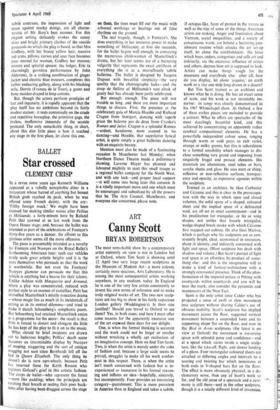Canny Scott
ART BRYAN ROBERTSON
The most remarkable show by a contemporary artist currently on view is not in London but at Oxford, where Tim Scott is showing until 12 April two very large recent sculptures in the Museum of Modern Art—a more solemn, certainly more spacious, Arts Laboratory. He is among the most consequential artists working anywhere, in any medium, today. In England he is one of the very few artists consistently to invent his own terms of reference and to make truly ,original works of art. The two new sculp- tures art too big to show in his fairly capacious London gallery (Waddington's). Is their size justified? Should you travel to Oxford to see them? Yes, in both cases, and here I must offer some reasons for the apparently excessive size of the art exposed these days for our delight.
One, is when the formal thinking is accurate and the work could not be larger or smaller without wrecking a wholly, apt realisation of an imaginative concept. Here we find Tim Scott.
, Two, is when the artist is merely under the yoke of fashion and, because a large scale seems to prevail, struggles to make all his work confor- mist in this respect. Three, is when the artist isn't much concerned with fashion but is in- experienced or immature in his formal reason- ing and inflates an idea—hopefully, sincerely, but incompetently. Four provides an interesting category—punishment. This is more prevalent in America than in England and takes a subtle, if octopus-like, form of protest in the nature as well as the size of some of the things American artists are making. Anger and frustration about Vietnam, social inequalities, and a society of conspicuous waste, are behind a hectoring pun- ishment routine which attacks the art set-up itself, let alone the establishment: the force which buys, orders, categorises and sells art and indirectly, via the excessive influence of critics and others, decrees how art is supposed to look. Artists can make things rough for the museums and everybody else: after all, how do you display, let alone 'acquire,' an earth work or a line one mile long drawn in a desert?
But Tim Scott trained as an architect and knows what he is doing. He has an exact sense of scale, and his work is not invariably im- mense: its range was clearly demonstrated in his 1967 Whitechapel show. At Oxford, a few of these earlier pieces are included to provide a context. What he offers are spectacles of the most dazzlingly beautiful kind, and this achieved by concentrating on apparently rather cerebral compositional elements. He has a powerfully independent colour sense, ranging through warm or cold greys to rich violet, orange or milky greens, but this is subordinate to a formal sensibility which manages to dis- close something very grand and imposing from singularly frugal and prosaic elements. His materials are aluminium, steel tubes or bars, acrylic sheets and glass. He uses matt or shiny, reflective or non-reflective surfaces, transpar- ency and opacity, as expressive agencies within the sculpture.
Trained as an architect, he likes Corbusier and Cezanne and this is clear in the preoccupa- tion with the way in which open and closed volumes, the solid space of a shaped, coloured sheet and the implied space of a delineated void, are all set in strict counterpoint—and in his predilection for triangular, or fin or wing shapes, not unlike that loosely triangular, wedge-shaped brush stroke with which Cezanne first mapped out cubism. He also likes Matisse, which is perhaps why his sculptures are so con- sistently bright, clear, economical in resources, sharp in identity, and indirectly concerned with light and space. (Most sculpture has dealt with shadow and volume.) But Scott's pursuit of light and space is an effortless by-product of some- thing else : and this is the imaginative will to make a kind of fantasy-architecture with a strongly ceremonial presence. Think of the plan- formation of the imperial palace at Peking with courtyards within courtyards and you will be near the mark; also consider the pyramids and monuments of the Near East.
Scott is the only artist since Calder who has projected a sense of swift or slow movement into sculpture without sharing Calder's use of obvious mobility. Scott's sculpture has implied movement across the floor, suggested vertical movement between a suspended form and its supporting shape flat on the floor, and now in the Bird in Arras sculptures (the latest is on view at Oxford) the movement is traversing space with splendid poise and confidence—and at a speed which varies inside a single sculp- ture, like the take-off, flight, and slower landing of a plane. Four rectangular coloured sheets are attached at differing angles and intervals to a soaring and twisting bar which terminates at both ends in V-shaped bars flat on the floor. The efftct is more obviously physical, in a de- clamatory sense, than any of Scott's work so far, and the old ,sense of a spectacle and a cere- mony is still there—and in the other sculpture, though it is a totally different kind of invention.


































 Previous page
Previous page